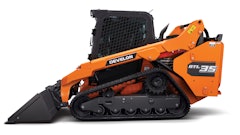
According to the U.S. Bureau of Labor statistics, construction trades workers had 2,120 eye-related injury or illness cases in 2020, while material moving workers had 1,860. Among construction trades workers, 31.1 percent of eye injury and illness cases involved construction laborers. Electricians made up 22.6 percent of these cases.
The Occupational Safety and Health Administration requires workers to use eye and face protection whenever there is a reasonable probability of injury. Eyewear personal protective equipment used when an eye hazard exists includes goggles, safety glasses, face shields and sometimes full-face respirators.
Clearing the Fog
The National Institute for Occupational Safety and Health (NIOSH) offers several recommendations to stop safety glasses from fogging, such as buying safety glasses that have anti-fog coatings put on during manufacturing.
The anti-fog coating on safety glasses creates a hydrophobic surface that repels water droplets and prevents fogging. Safety glasses without this coating are more prone to fogging. Be aware, however, that this coating can wear off over time and may not be suitable for all lens types.
Use anti-fog solutions on the lenses regularly if needed. Applying a commercial anti-fog gel, spray or wipe forms a barrier, protecting the lens from moisture and temperature changes. Repeated application may damage the anti-reflective coating on some lenses. Make sure the product meets OSHA safety standards.
Washing safety glasses regularly with soap and water and letting them air dry can help prevent fogging. That may entail using dish soap or shaving cream with glycerin on the lenses. After rubbing the shaving cream on the lenses, allow it to dry prior to getting rid of the residue by gently using a soft, dry cloth.
Baby shampoo can be another option. Mix a small amount of it with water in a spray bottle. Spray a fine mist onto the lenses. Buff dry with a clean cloth.
Keep lenses clean and unscratched.
Workers also may try wearing a sweat band on their forehead or cool rag in their hard hat. Moving the eyewear slightly down the nose may be enough to stimulate proper air circulation and reduce fog risk. Take breaks in cooler, drier environments if possible.
Factors Causing Foggy Safety Glasses
A common cause is warm breath. When warm, moist breath is exhaled, it condenses on the cooler lenses and creates fog. This can happen more frequently in cold weather or when wearing a mask, which traps breath near the lenses.
High humidity is another factor. If the surrounding air is humid, it can condense on the safety glass lenses, especially if they are cooler than the air. Dirt, dust,and oil can attract moisture and promote fogging.
Safety glasses that fit too snugly around the face may trap warm, humid air near the lenses and increase fogging. Seek masks with a snug fit around the nose and cheeks to prevent warm air from escaping and fogging the glasses. If need be, adjust the mask to minimize airflow toward the lenses.
Glasses that lack vents or have poor airflow traps moisture and fogs up the lenses. Fogging can worsen with prescription safety glasses, as additional layers trap heat and moisture. Strenuous work that generates heat or sweat adds moisture and heat that contributes to fogging.
Risks of Foggy Safety Glasses
The NIOSH notes that potential eye hazards include hammering, grinding, sanding and masonry work that may produce particles; handling chemicals that may lead to splashes in the eye; wet or powdered cement in the eye that can cause a chemical burn and welding that leads to exposure to arcs and flashes (intense UV radiation) for welders, helpers and bystanders.
Other hazards include dusty or windy conditions that can lead to particles in the eye. Eye injuries can result from simply passing through an area where work is being performed. Nearby co-workers also may generate a hazard.
The very purpose of safety glasses is to protect the worker from debris, flying particles and light to moderate impact and help prevent damage to a worker’s vision from dangerous chemicals, dust, airborne chemicals and other hazards.
Glasses that are fogged up compromise their ability to provide construction workers that protection, making it difficult and dangerous to see and may negate the rules and regulations associated with their use.

























